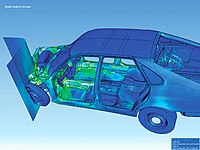
Photo from wikipedia
Abstract Three-dimensional (3D) vibration behavior of elastic parallelepipeds, including beams, plates, and solids, is critical for a wide range of engineering applications. However, obtaining accurate 3D solutions of parallelepipeds is… Click to show full abstract
Abstract Three-dimensional (3D) vibration behavior of elastic parallelepipeds, including beams, plates, and solids, is critical for a wide range of engineering applications. However, obtaining accurate 3D solutions of parallelepipeds is a relatively challenging task. In this paper, a novel and general 3D weak form quadrature element method (QEM) is presented for solutions of vibrations of parallelepipeds with different combinations of boundary conditions. The element stiffness and mass matrices are explicitly derived via the numerical integration together with the differential quadrature (DQ) law. A number of case studies on beams, thin and thick plates, and 3D solids with different combinations of boundary conditions have been conducted. The natural frequencies and mode shapes were in excellent agreement with existing results and data obtained by the finite element method with a very fine mesh. It is seen that the proposed 3D quadrature element is simple in formulations, computationally efficient and capable of capturing the 3D vibration behavior of parallelepipeds with high precision. In addition, some new frequencies and mode shapes are provided to augment the archived reference frequencies and mode shapes.
Journal Title: Finite Elements in Analysis and Design
Year Published: 2018
Link to full text (if available)
Share on Social Media: Sign Up to like & get
recommendations!